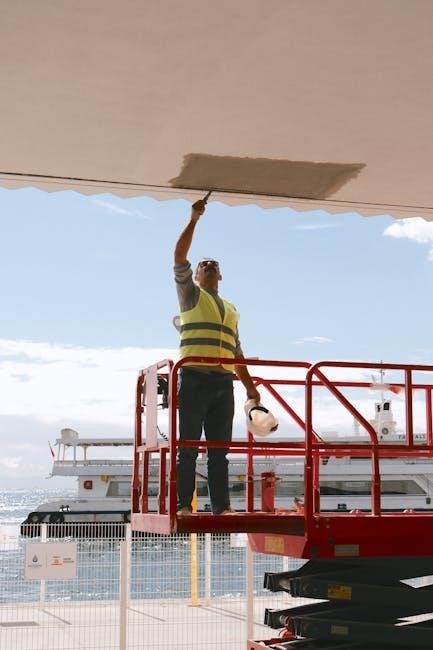A boat lift is a crucial investment for boat owners, providing protection and convenience. It elevates the boat above water, preventing damage and barnacle growth. Proper fitting and installation ensure safety and longevity, while regular maintenance keeps the system functioning smoothly.

What is a Boat Lift

A boat lift, also known as a boat hoist or lift, is a device designed to raise and lower boats out of the water. It is typically installed in marinas, docks, or private boat slips to protect the vessel from water damage, corrosion, and marine growth. By elevating the boat, it prevents it from floating away and reduces the risk of hull damage caused by waves or storms. Boat lifts are especially useful in shallow water and areas with fluctuating water levels, ensuring the boat remains secure and stable. They are also convenient for maintenance and repair, as they allow easy access to the hull and underside of the boat. Most boat lifts are designed to accommodate specific boat sizes and weights, making them a practical solution for boat owners seeking to extend the lifespan of their vessel and enhance their overall boating experience.

Types of Boat Lifts
Boat lifts vary in design, including hydraulic, electric, and manual systems. Hydraulic lifts offer powerful lifting capacity, while electric lifts provide quiet operation. Manual lifts are cost-effective but require more effort. Each type suits different boat sizes and docking needs.
Hydraulic Lifts
Hydraulic boat lifts are a popular choice for their robust performance and reliability; These systems use hydraulic cylinders to lift and lower boats, offering smooth and precise operation. They are ideal for heavier boats and larger watercraft, as they can handle significant weight with ease. Hydraulic lifts are known for their durability and require less maintenance compared to other types of lifts. They are also quieter in operation, making them a preferred option for many boat owners. The hydraulic system ensures that the boat is lifted evenly, reducing the risk of damage. Additionally, hydraulic lifts can be customized to fit different dock configurations and boat sizes. With proper installation, they provide a safe and efficient way to protect your boat from water damage and extend its lifespan. Their strength and reliability make hydraulic lifts a top choice for boat owners seeking a high-quality lifting solution.

Installation
Proper installation of a boat lift ensures durability and safety. Assess dock strength, secure the lift with sturdy hardware, and align it with the boat’s center of gravity. Use lifting straps for even weight distribution and test the system with a small load first.

Step-by-Step Guide
Installing a boat lift requires careful planning and execution. First, assess the dock’s structural integrity to ensure it can support the lift and boat weight. Next, position the lift frame securely, aligning it with the boat’s center of gravity. Attach the lifting straps or cables evenly, ensuring they are not twisted or over-tightened. Tighten all bolts and connections to prevent movement. Finally, test the lift with a small load to ensure stability and function. Always follow manufacturer guidelines and consider professional assistance if unsure. Proper installation ensures years of reliable service and protects your boat from damage.

Safety

Regularly inspect the lift for wear and tear. Ensure the boat is properly secured to prevent shifting. Always follow weight capacity guidelines to avoid overloading. Keep the area clear of obstacles and ensure proper ventilation to prevent accidents.
Best Practices
When using a boat lift, it’s essential to follow best practices to ensure safety and longevity. Always begin by thoroughly inspecting the lift for any signs of wear or damage. Check the straps, cables, and pulleys for fraying or corrosion, and replace any worn components immediately to prevent accidents.
Next, ensure your boat is properly aligned with the lift before raising it. Misalignment can cause uneven stress on the lift and potentially damage your boat. Use guideposts or rails to help center the boat as you guide it into position.
After securing the boat, double-check all straps and safety latches to ensure they are tightly fastened. Avoid overloading the lift by staying within the recommended weight capacity, especially when considering the added weight of fuel, gear, and passengers.

Regular maintenance is also crucial. Grease moving parts periodically and inspect the lift’s electrical components to ensure they are functioning correctly. Finally, always follow the manufacturer’s instructions for operation and maintenance to maximize the life of your boat lift and ensure safe usage.

Maintenance
Regular maintenance ensures your boat lift operates safely and efficiently. Check straps for wear, grease moving parts, and inspect for corrosion. Ensure proper alignment to prevent damage and maintain structural integrity. Address any issues promptly to extend the lift’s lifespan.
Routine Checks
Regular inspections are essential to ensure your boat lift functions properly. Start by examining the lifting straps for signs of wear, fraying, or corrosion. Check the hydraulic system for any leaks or fluid loss, as this can lead to mechanical failure. Inspect the frame and beams for rust or structural damage, especially in saltwater environments where corrosion is more prevalent. Ensure all bolts and screws are tightened securely, as loose hardware can compromise safety. Test the lift’s operation by raising and lowering the boat slowly, listening for unusual noises or jerking motions. Additionally, verify that the boat is properly centered on the lift to avoid uneven stress on the bunks or rollers. If you notice any issues, address them immediately to prevent further damage. Finally, lubricate moving parts annually to maintain smooth operation and extend the lifespan of your boat lift.
